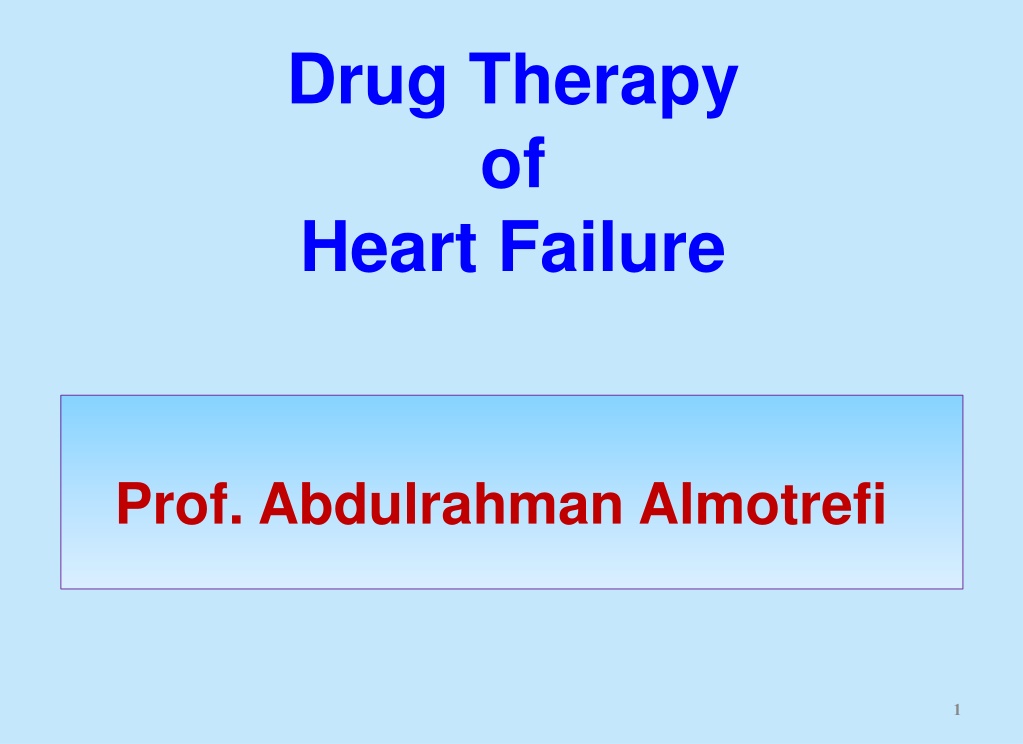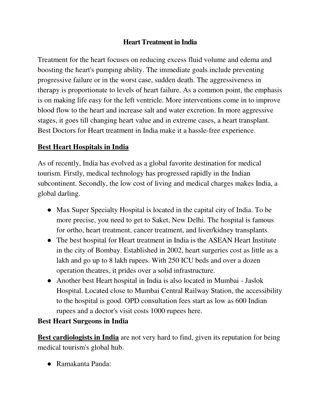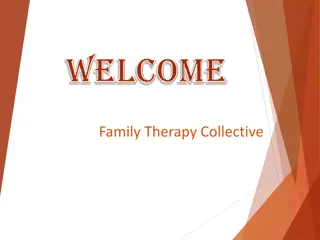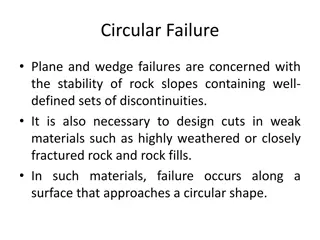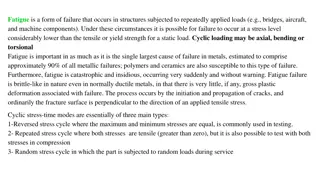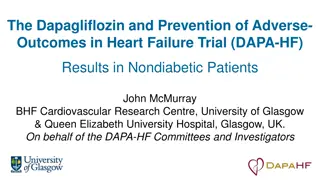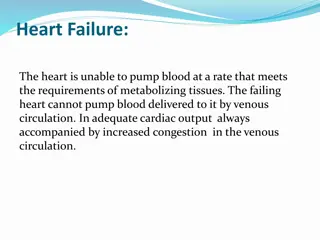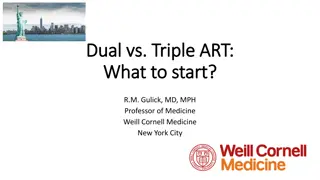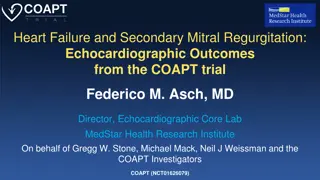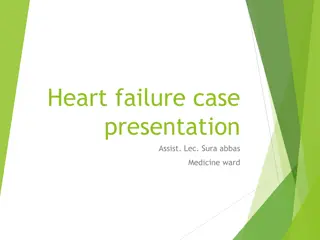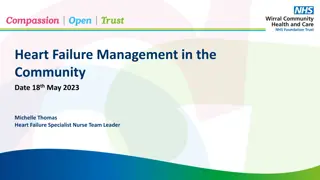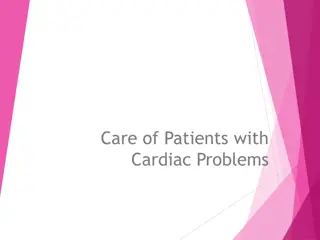Drug Therapy of Heart Failure
Explore the various classes of drugs used for treating acute and chronic heart failure, including their mechanisms of action, pharmacological effects, clinical uses, adverse effects, and interactions with other drugs. Learn about the causes, symptoms, pathophysiology, and factors affecting cardiac output in heart failure, along with the drugs used to decrease preload, afterload, and both preload and afterload in treatment.
Download Presentation

Please find below an Image/Link to download the presentation.
The content on the website is provided AS IS for your information and personal use only. It may not be sold, licensed, or shared on other websites without obtaining consent from the author. Download presentation by click this link. If you encounter any issues during the download, it is possible that the publisher has removed the file from their server.
E N D
Presentation Transcript
Drug Therapy of Heart Failure Prof. Abdulrahman Almotrefi 1
Learning objectives By the end of this lecture, students should be able to: - Describe the different classes of drugs used for treatment of acute & chronic heart failure and their mechanism of action - Understand their pharmacological effects, clinical uses, adverse effects and their interactions with other drugs
HEART FAILURE ? Inability of the heart to maintain an adequate cardiac output to meet the metabolic demands of the body.
CAUSES OF HEART FAILURE CAUSES OF HEART FAILURE
Symptoms of Heart failure - Tachycardia - Decreased exercise tolerance (rapid fatigue) - Dyspnea ( pulmonary congestion ) - Peripheral edema - Cardiomegaly 5
Pathophysiology of CHF Force of contraction Low C.O. Carotid sinus firing Activate sympathetic system Sympathetic discharge Activate renin-angiotensin- Aldosterone system Remodeling Salt & Water Retention Volume expansion Vasoconstriction Force of Cardiac .cont. HR Venous VC Arterial VC Preload Preload Afterload
Factors affecting cardiac output and heart failure 1- Preload 2- Afterload 3- Cardiac contractility 8
Drugs used in treatment of heart failure I- Drugs that decrease preload: 1 - Diuretics 2 - Aldosterone antagonists 3 - Venodilators II- Drugs that decrease afterload: 1 - Arteriodilators 9
Drugs used in treatment of heart failure III- Drugs that decrease both preload & afterload: ( Combined arteriolo- & venodilators ) 1- Angiotensin converting enzyme (ACE) inhibitors 2- Angiotensin receptor antagonists 3- 1-adrenoceptor antagonists 4- Direct vasodilators 10
Drugs used in treatment of heart failure IV- Drugs that increase contractility: 1- Cardiac glycosides (digitalis) 2- - adrenoceptor agonists 3- Phosphodiesterase inhibitors 11
I- Drugs that decrease preload 1-Diuretics: Mechanism of action in heart failure : reduce salt and water retention decrease ventricular preload and venous pressure reduction of cardiac size Improvement of cardiac performance 12
I- Drugs that decrease preload 1-Diuretics: Chlorothiazide - first-line agent in heart failure therapy - used in volume overload ( pulmonary and/ or peripheral edema ) - used in mild congestive heart failure 13
I- Drugs that decrease preload 1-Diuretics: Furosemide - a potent diuretic - used for immediate reduction of pulmonary congestion & severe edema associated with : - acute heart failure - moderate & severe chronic failure 14
I- Drugs that decrease preload 2-Aldosterone antagonists: Spironolactone - nonselective antagonist of aldosterone receptor - a potassium sparing diuretic - improves survival in advanced heart failure 15
I- Drugs that decrease preload 2-Aldosterone antagonists: Eplerenone - a new selective aldosterone receptor antagonist ( does not inhibit other hormones such as estrogens & androgens) - indicated to improve survival of stable patients with congestive heart failure 16
I- Drugs that decrease preload 3-Venodilators: Nitroglycerine Isosorbide dinitrate - used I.V. for severe heart failure when the main symptom is dyspnea due to pulmonary congestion - dilates venous blood vessels and reduce preload 17
II- Drugs that decrease afterload 1- Arteriodilators: Hydralazine - used when the main symptom is rapid fatigue due to low cardiac output - reduce peripheral vascular resistance 18
III- Drugs that decrease both preload & afterload 1-Angiotensin converting enzyme (ACE) inhibitors: - considered as first-line drugs for chronic heart failure along with diuretics - first-line drugs for hypertension therapy 19
Angiotensin converting enzyme inhibitors MECHANISM OF ACTION VASOCONSTRICTION VASODILATATION ALDOSTERONE VASOPRESSIN SYMPATHETIC Angiotensinogen RENIN BRADYKININ Angiotensin I A.C.E. Inhibitor Breackdown ANGIOTENSIN II
ACE Inhibitors Pharmacological actions: 1 - Decrease peripheral resistance ( Afterload ) 2 - Decrease Venous return ( Preload) 3 - Decrease sympathetic activity 4- Inhibit cardiac and vascular remodeling associated with chronic heart failure Decrease in mortality rate 21
ACE Inhibitors Pharmacokinetics: Captopril, Enalapril and Ramipril - rapidly absorbed from GIT after oral administration. - food reduce their bioavailability Enalapril , Ramipril - prodrugs, converted to their active metabolites in liver - have long half-life & given once daily 22
ACE Inhibitors Adverse effects: 1- acute renal failure, especially in patients with renal artery stenosis 2- hyperkalemia, especially in patients with renal insufficiency or diabetes 3- severe hypotension in hypovolemic patients (due to diuretics, salt restriction or gastrointestinal fluid loss) 23
ACE Inhibitors Adverse effects: 4- dry cough sometimes with wheezing 5- angioneurotic edema ( swelling in the nose , throat, tongue, larynx) 6- dysgeusia ( reversible loss or altered taste) 24
ACE Inhibitors Contraindications: - during the second and third trimesters of pregnancy ( due to the risk of : fetal hypotension renal failure & malformations ) - renal artery stenosis 25
III- Drugs that decrease both preload & afterload 2- Angiotensin receptor blockers (ARBs) : Losartan, Valsartan , Irbesartan Mechanism of action: - block AT1 receptors - decrease action of angiotensin II 26
III- Drugs that decrease both preload & afterload 3- -ADRENOCEPTOR BLOCKERS : Prazosin - blocks - receptors in arterioles and venules - decrease both afterload & preload 27
III- Drugs that decrease both preload & afterload 4- Direct acting vasodilators: Sodium nitroprusside - given I.V. for acute or severe heart failure - acts immediately and effects lasts for 1-5 min. 28
IV- Drugs that increase contractility 1- Cardiac glycosides ( digitalis) : Digoxin -increases the force of myocardial contraction ( +ve inotropic effect ) Mechanism of action : - Inhibit Na+ / K+ ATPase enzyme ( the sodium pump ) 29
IV- Drugs that increase contractility 1- Cardiac glycosides ( digitalis) : Digoxin Therapeutic uses: - Congestive heart failure - has narrow therapeutic index 31
IV- Drugs that increase contractility 1- Cardiac glycosides ( digitalis) : Digoxin Adverse effects (Cardiac): - digitalis-induced arrhythmias - extrasystoles - coupled beats (Bigeminal rhythm) - ventricular tachycardia or fibrillation - cardiac arrest 32
IV- Drugs that increase contractility 1- Cardiac glycosides ( digitalis) : Digoxin Adverse effects (non-cardiac) : GIT : anorexia ,nausea, vomiting, diarrhea CNS: headache, visual disturbances, drowsiness 34
IV- Drugs that increase contractility 1- Cardiac glycosides ( digitalis) : Digoxin Factors that increase its toxicity: - Renal diseases - Hypokalemia - Hypomagnesemia - Hypercalemia 35
IV- Drugs that increase contractility 2- -Adrenoceptor agonists: Dobutamine - Selective 1 agonist - Uses : Treatment of acute heart failure in cardiogenic shock 36
IV- Drugs that increase contractility 3- phosphodiesterase -III inhibitors: Milrinone Mechanism of action: - Inhibits phosphodiesterase -III ( cardiac & B. Vessels) which inhibits cAMP degradation ( cAMP ) Increase cardiac dilatation of arteries & veins Contractility (reduction of preload & afterload ) 37
IV- Drugs that increase contractility 3- phosphodiesterase -III inhibitors : Milrinone Therapeutic uses: - used only intravenously for management of acute heart failure - not safe or effective in the longer ( > 48 hours) treatment of patients with heart failure 38
IV- Drugs that increase contractility 3- phosphodiesterase -III inhibitors : Milrinone Adverse effects: - Hypotension and chest pain (angina?) Chemical interaction: - furosemide should not be administered in I.V. lines containing milrinone due to formation of a precipitate - Enoximone & Vesnarinone new drugs in clinical trials 39
The use of -adrenoceptor blockers in heart failure - The elevated adrenergic activity in chronic heart failure patients cause structural remodeling of the heart (cardiac dilatation & hypertrophy) -blockers: - reduce the progression of chronic heart failure - not used in acute heart failure 40
The use of -adrenoceptor blockers in heart failure Mechanism of action of -blockers in HF: 1- attenuate cardiac remodeling 2- slow heart rate, which allows the left ventricle to fill more completely 3- decrease renin release reduce mortality & morbidity of patients with HF 41
The use of -adrenoceptor blockers in heart failure - Second generation: cardioselective ( 1-receptors ) e.g. Bisoprolol, Metoprolol - Third generation: have vasodilator actions ( - blocking effect) e.g. Carvedilol , Nebivolol 42
New drugs for heart failure 1- Natriuretic Peptides: Nesiritide - BNP is secreted by the ventricules in response to stretch - elevated BNP is associated with advanced heart failure ( compensatory mechanism in HF ) 43
Natriuretic Peptides Nesiritide - a purified preparation of human BNP, manufactured by recombinant DNA technology - cyclic-GMP in vascular smooth muscle, leading to smooth muscle relaxation & reduction of preload and afterload - indicated for the treatment of patients with acute decompensated heart failure (ADHF) who have dyspnea at rest or with minimal activity 44
New drugs for heart failure 2- Calcium sensitisers: Levosimendan mechanism of action: - Calcium sensitization (improves cardiac contractility without increasing oxygen consumption) - potassium-ATP channel opening (cause vasodilation, improving blood flow to vital organs) These effects reduce the risk of worsening CHF or death compared with dobutamine 45
Management of chronic heart failure Reduce work load of the heart - Limit patient activity - Reduce weight - Control hypertension Restrict sodium Stop smoking 46
Heart Failure Functional Classification NYHA Class Symptoms Cardiac disease, but no symptoms and no limitation in ordinary physical activity, e.g. no shortness of breath when walking, climbing stairs etc. I Mild symptoms (mild shortness of breath and/or angina), slight limitation during ordinary activity. II Marked limitation in activity due to symptoms, even during less-than-ordinary activity, e.g. walking short distances (20 100 m).Comfortable only at rest. III Severe limitations. Experiences symptoms even while at rest. Mostly bedbound patients. IV 47
Congestive Heart Failure in Black patients Hydralazine/isosorbide dinitrate fixed dose combination - FDA approved to add to standard therapy for black Americans with congestive heart failure ( due to poor response to ACE inhibitors ) - should be considered for patients intolerant to ACE inhibitors & ARBs due to renal dysfunction 49
